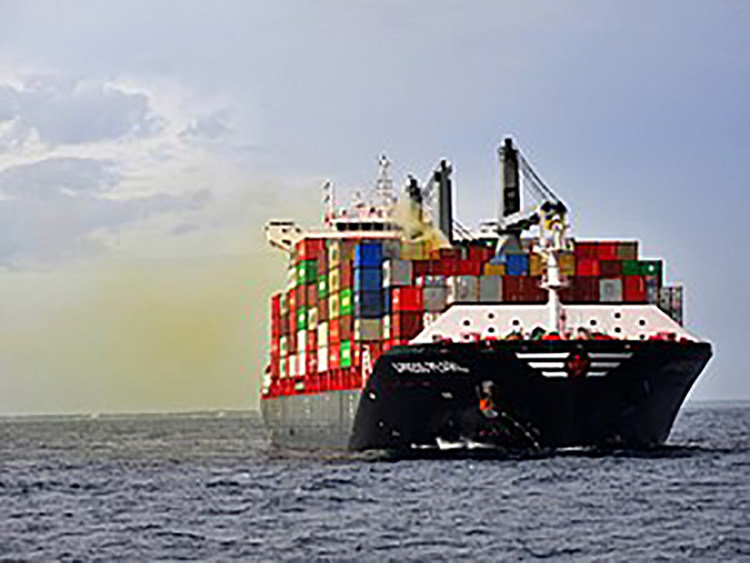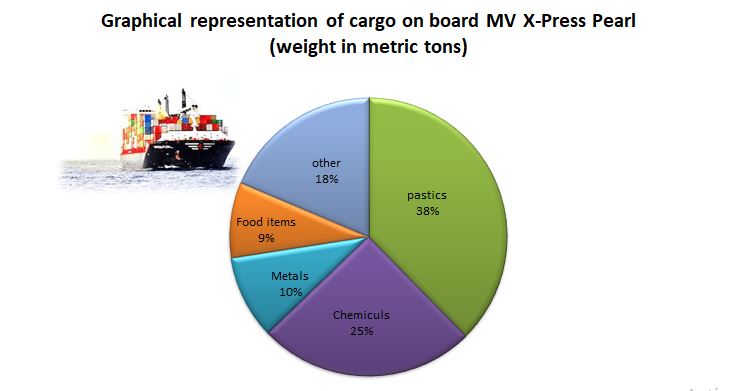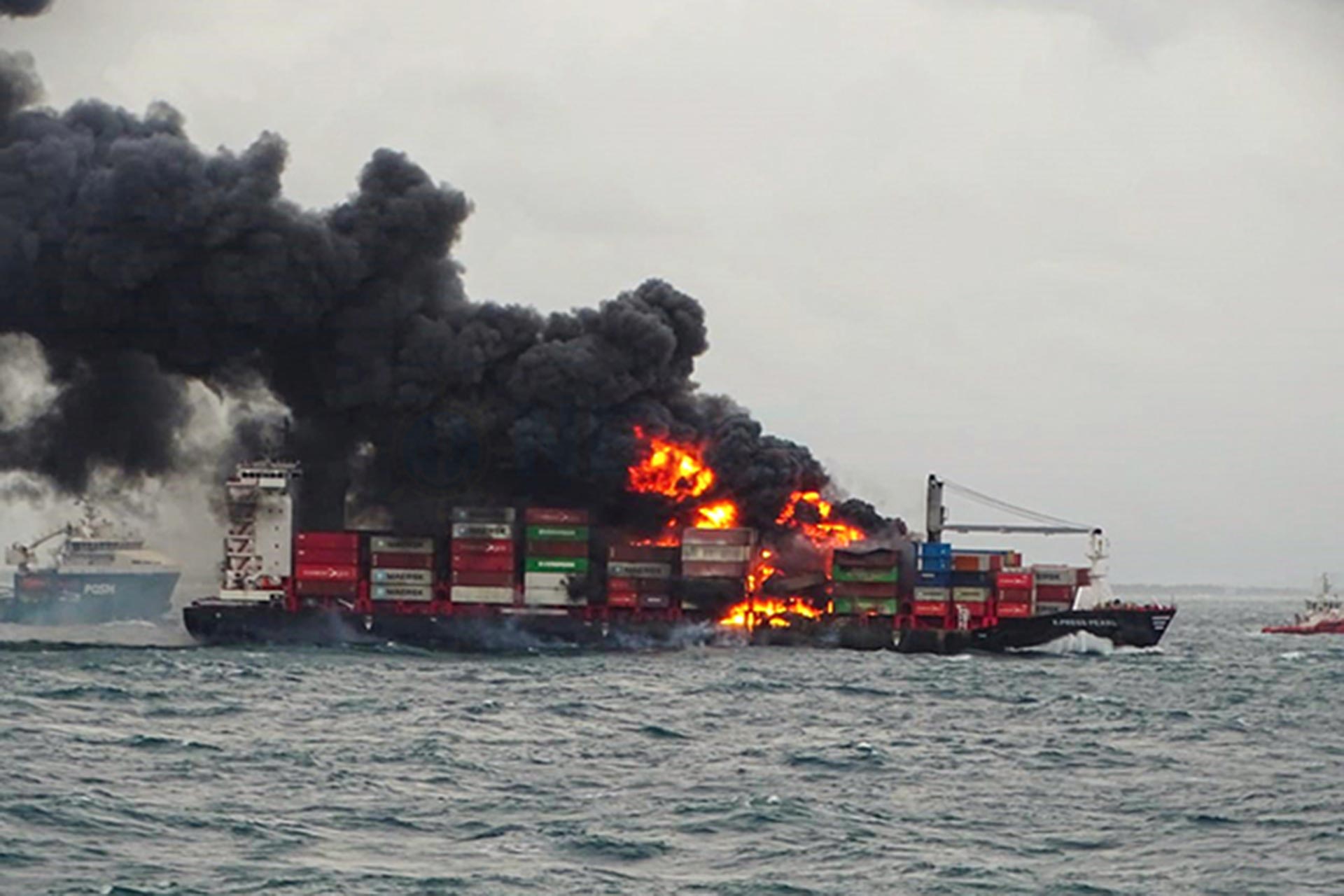A Singapore-registered container ship that caught fire and sunk off the coast of Sri Lanka has left thousands of tons of toxic material on the ocean floor.
With more than 29,000 metric tons of the 31,701.6 metric tons of cargo on board the Super Eco 2700 class container ship MV X-Press Pearl catching fire and sinking off the coast of Colombo, Sri Lanka, yet to be salvaged, the danger of marine ecological pollution looms large and could be best described as a chain of time bombs beneath the ocean.
The sinking of the X-Press Pearl is said to be the worst marine ecological disaster in Sri Lankan history and was the hottest topic in the country at that time. Sixteen months on, the incident has been forgotten by most and hardly makes the news. The public is not aware that the worst is yet to come as 93.6% of the cargo is still beneath the ocean.
The irony is that the officials who know about the impending disaster are not taking any action to mitigate it. They know very well that the marine ecological disaster which took place in June 2021 is just the tip of the iceberg as the bulk of the cargo lies beneath the ocean.
This investigative report was compiled after extensive research and use of the Right To Information (RTI) as an eye opener because the Sri Lanka government continue to keep the public in the dark on matters relating to the incident. Namely the impending damage to the marine ecology and the delay in instigating legal action to claim compensation for the environmental damage and loss of livelihood caused.
The Singapore-registered container carrier operated by X-Press Feeders was on its third voyage and returning to her home port. The vessel was off the coast of Colombo Sri Lanka when a fire broke out on board on May 20, 2021 and burned for 12 days before sinking on June 2.

Information obtained from the Sri Lanka Customs Department (SLCD), Sri Lanka Ports Authority (SLPA) and the Marine Environment Protection Authority (MEPA) through RTI confirms that there were 1,486 containers on board the vessel. Of these, 445 containers were laden with plastic and rubber, 120 containers with chemicals and related products, 81 containers with hazardous items such as nitric acid and caustic soda, and 568 containers with other miscellaneous items, while 272 containers were empty.
Information obtained from the MEPA revealed that 15 varieties of hazardous goods weighing 1809.3 metric tons and classified as International Maritime Dangerous Goods (IMDG) were stored in 81 containers which were on board. Most of the goods had been loaded on board in the United Arab Emirates and Qatar and bound for Singapore while 68.2 metric tons classified as IMDG-4.2 and 29.5 metric tons classified as IMDG-9 were to be unloaded at the port of Colombo.

Pollution of the ocean and shoreline
In a document obtained through RTI from MEPA, it was revealed that no government institution in Sri Lanka was aware of the exact quantity of cargo that made its way into the marine environment.
The July 2021 report of the United Nations Environmental Program (UNEP) suggests that the 210 metric tons of methanol stored on the top deck of the ship would have been destroyed by the fire. It could also be assumed that part of the 9,700 metric tons of Epoxy Resin which was stored in 349 containers may have been destroyed by the fire or made its way into the ocean. Epoxy resin is not classified as hazardous but could be a threat to the marine environment. The total weight of cargo salvaged including the quantity of epoxy resin and methanol presumed to have been destroyed is 2029.64 metric tons.

The UNEP report also suggests that the probability that all of the 348 metric tons of intermediate fuel oil (IFO) on board the vessel being destroyed by the fire was remote and that a considerable amount of fuel oil which was stored in tanks beneath the waterline of the vessel would have gone down with it. Director of the Center of Environmental Justice (CEJ) and environment scientist Hemantha Withanage believes that the fuel oil is bound to seep out of its tanks in the future.

The MEPA report confirms that more than 1,680 metric tons of debris including a large number of nurdles had washed ashore. Resole Marine which had been entrusted with the salvage operation has stated that an assortment of debris including burnt containers had been salvaged from 347 locations but do not mention the weight of the debris salvaged. In reply to a query made through RTI Sri Lanka Customs Department confirmed that 139.64mt of debris had been salvaged.
Withanage confirmed that most of the debris was washed onto the Sarakkuwa beach opposite which the vessel had sunk.
Nurdles
The harm caused to the marine ecology by the 1,680 metric tons of nurdles which were stored in 87 containers on board MV X-Press Pearl was immense. With each nurdle weighing a mere 0.02 grams, calculations show that there were more than 84 billion nurdles in the 87 containers. It is not known how much spilled out when the ship sank and how much went down with it.

Information and maps obtained from the National Aquatic Resources Research and Development Agency (NARA) through RTI, confirm that plastics, microplastics, heavy metals, sediments and plankton were among the debris collected from the beaches between Negombo and Kalutara and also within the Negombo Lagoon.
According to the World Health Organization (WHO), persistent organic pollutants (POPs) including polychlorinated biphenyls (PCBs), organochlorine pesticides and industrial chemicals cause extensive harm to the environment as well as human health.









